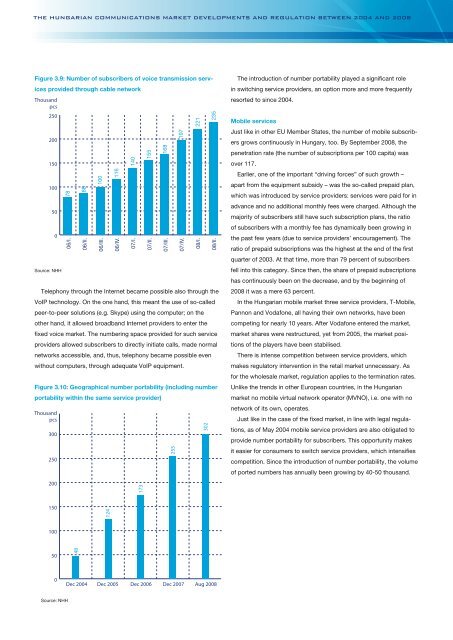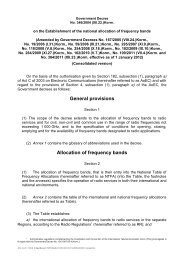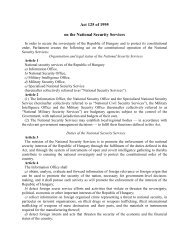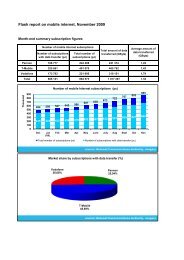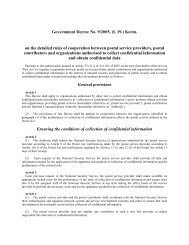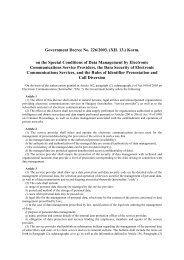The Hungarian Communications Market Developments and ...
The Hungarian Communications Market Developments and ...
The Hungarian Communications Market Developments and ...
You also want an ePaper? Increase the reach of your titles
YUMPU automatically turns print PDFs into web optimized ePapers that Google loves.
<strong>The</strong> <strong>Hungarian</strong> <strong>Communications</strong> <strong>Market</strong> <strong>Developments</strong> <strong>and</strong> Regulation between 2004 <strong>and</strong> 2008<br />
Figure 3.9: Number of subscribers of voice transmission services<br />
provided through cable network<br />
Thous<strong>and</strong><br />
pcs<br />
250<br />
200<br />
150<br />
100<br />
50<br />
0<br />
Source: NHH<br />
Telephony through the Internet became possible also through the<br />
VoIP technology. On the one h<strong>and</strong>, this meant the use of so-called<br />
peer-to-peer solutions (e.g. Skype) using the computer; on the<br />
other h<strong>and</strong>, it allowed broadb<strong>and</strong> Internet providers to enter the<br />
fixed voice market. <strong>The</strong> numbering space provided for such service<br />
providers allowed subscribers to directly initiate calls, made normal<br />
networks accessible, <strong>and</strong>, thus, telephony became possible even<br />
without computers, through adequate VoIP equipment.<br />
Figure 3.10: Geographical number portability (including number<br />
portability within the same service provider)<br />
Thous<strong>and</strong><br />
pcs<br />
300<br />
250<br />
200<br />
78<br />
06/I.<br />
88<br />
06/II.<br />
100<br />
06/III.<br />
116<br />
06/IV.<br />
140<br />
07/I.<br />
173<br />
155<br />
07/II.<br />
168<br />
07/III.<br />
255<br />
197<br />
07/IV.<br />
221<br />
08/I.<br />
302<br />
235<br />
08/II.<br />
<strong>The</strong> introduction of number portability played a significant role<br />
in switching service providers, an option more <strong>and</strong> more frequently<br />
resorted to since 2004.<br />
Mobile services<br />
Just like in other EU Member States, the number of mobile subscribers<br />
grows continuously in Hungary, too. By September 2008, the<br />
penetration rate (the number of subscriptions per 100 capita) was<br />
over 117.<br />
Earlier, one of the important “driving forces” of such growth –<br />
apart from the equipment subsidy – was the so-called prepaid plan,<br />
which was introduced by service providers: services were paid for in<br />
advance <strong>and</strong> no additional monthly fees were charged. Although the<br />
majority of subscribers still have such subscription plans, the ratio<br />
of subscribers with a monthly fee has dynamically been growing in<br />
the past few years (due to service providers’ encouragement). <strong>The</strong><br />
ratio of prepaid subscriptions was the highest at the end of the first<br />
quarter of 2003. At that time, more than 79 percent of subscribers<br />
fell into this category. Since then, the share of prepaid subscriptions<br />
has continuously been on the decrease, <strong>and</strong> by the beginning of<br />
2008 it was a mere 63 percent.<br />
In the <strong>Hungarian</strong> mobile market three service providers, T-Mobile,<br />
Pannon <strong>and</strong> Vodafone, all having their own networks, have been<br />
competing for nearly 10 years. After Vodafone entered the market,<br />
market shares were restructured, yet from 2005, the market positions<br />
of the players have been stabilised.<br />
<strong>The</strong>re is intense competition between service providers, which<br />
makes regulatory intervention in the retail market unnecessary. As<br />
for the wholesale market, regulation applies to the termination rates.<br />
Unlike the trends in other European countries, in the <strong>Hungarian</strong><br />
market no mobile virtual network operator (MVNO), i.e. one with no<br />
network of its own, operates.<br />
Just like in the case of the fixed market, in line with legal regulations,<br />
as of May 2004 mobile service providers are also obligated to<br />
provide number portability for subscribers. This opportunity makes<br />
it easier for consumers to switch service providers, which intensifies<br />
competition. Since the introduction of number portability, the volume<br />
of ported numbers has annually been growing by 40-50 thous<strong>and</strong>.<br />
150<br />
124<br />
100<br />
50<br />
48<br />
0<br />
Dec 2004 Dec 2005 Dec 2006 Dec 2007 Aug 2008<br />
Source: NHH


